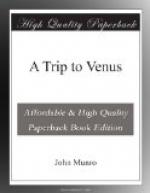“Saturn, the ‘ringed planet,’ who appears as a dull red star of the first magnitude, is the most interesting of all the planets. He is 884 million miles from the sun; his period of revolution is 291/2 years, and he turns on his axis in 10 hours 14 minutes. His diameter is 75,000 miles, but his mass is only 94 times that of the earth, for he is lighter than pinewood. His atmosphere is marked with spots and belts, and on the whole his condition is like that of Jupiter.
“Two flat rings or hoops, divided by a dark space, encircle his ball in the plane of his equator. The inner ring is over 18,000 miles from the ball, and nearly 17,000 miles broad. The gap between is 1,750 miles wide, and the outer ring is over 10,000 miles broad. The rings are banded, bright or dark, and vary in thickness from 40 to 250 miles. They consist of innumerable small satellites and meteoric stones, travelling round the ball in rather more than ten hours, and are brightest in their densest parts. Of course they form a magnificent object in the night sky of the planet, and it may be that our own zodiacal light is the last vestige of a similar ring, and not an extension of the solar corona.
“Saturn has eight moons outside his rings, the nearest, Mimas, being 115,000, and the farthest, Japetus, 220,400 miles from his ball. With the exception of Japetus, they revolve round him in the plane of his rings, and when these are seen edgewise, appear to run along it like beads on a string.
“Uranus, the next planet visible, is a pale star of the sixth magnitude, 1,770 million miles from the sun, and completes his round in 84 years. His axis, differing from those of the foregoing planets, lies almost in the plane of his orbit, but we cannot speak as to his axial rotation. He is 31,000 miles in diameter, and somewhat heavier, bulk for bulk, than water. Four satellites revolve round him, the nearest, Ariel, being 103,500, and the farthest, Oberon, 347,500 miles distant. Unlike the orbits of the foregoing satellites, which are nearly in the same plane as the orbits of their primaries, those of the satellites of Uranus are almost perpendicular to his own. They are travelled in periods of two and a half to thirteen and a half days.
“Neptune, invisible to the naked eye, but seen as a pale blue star in the telescope, is 2,780 million miles from the sun, and makes a revolution in 165 years. His diameter is about 35,000 miles, and his density rather less than that of water.
“Neptune has one satellite, at a distance of 202,000 miles, which, like those of Uranus, revolves about its primary in an orbit at a considerable angle to his own in five days twenty-one hours. Both Neptune and Uranus are probably dying suns.
“Comets of unknown number travel in long elliptical or parabolic orbits round the sun at great velocities. They seem to consist partly of glowing vapours, especially hydrogen, and partly of meteoric stones. ‘Shooting stars,’ that is to say, stones which fall to the earth, are known to swarm in their wake, and are believed to be as plentiful in space as fishes in the sea.”




